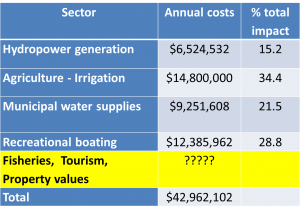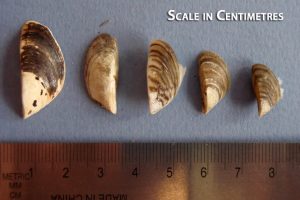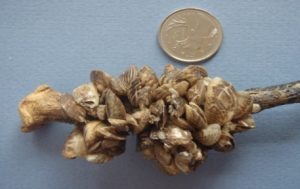CCRIFC Compliance & Enforcement

Mission Statement
The Canadian Columbia River Inter-tribal Fisheries Commission (CCRIFC) Fishery Guardian serves to uphold the fisheries and aquatic laws of CCRIFC member Nations, the government of Canada and the province of British Columbia in order to protect fish and fish habitats and traditional and contemporary fishing values of the Canadian Columbia River Basin.
Meet your CCRIFC Stewardship and Protection Unit Team
Welcome to the CCRIFC Fisheries Stewardship and Protection Unit page!
CCRIFC Fishery Guardians act on behalf of our membership communities to protect the fish and fish habitats in all of the territory including the lower Columbia River and Arrow Lakes Reservoir.
The CCRIFC Stewardship and Protection Unit is currently made up of three dedicated staff:
Kenton Andreashuk – Supervisor
Jim Clarricoates – Restorative Justice
Danielle Gravelle – General Field Patrol Duties. Danielle is the newest member of the team. Welcome Danielle!
Our primary focus is:
- Protection of fish Species at Risk (White Surgeon and Umatilla Dace) and their habitats through compliance and enforcement patrols.
- Compliance monitoring for lakes that have shoreline guidelines in effect.
- Monitoring industrial use areas.
- Joint compliance and enforcement patrols with DFO Fisheries Officers in support of the BC Freshwater Fishing Regulations, Fisheries Act and the Species at Risk Act.
- Compliance and enforcement patrols of spawning channels.
- We are also called upon by DFO to initiate Fisheries Act investigations by collecting evidence and conducting initial site assessments to be used further in investigations.
What is a Fishery Guardian?
A Fishery Guardian is an enforcement officer designation appointed by DFO. Fishery Guardians operate in a similar capacity as a Fishery Officer but with not as broad of powers. CCRIFC Fishery Guardians do not enforce the BC Freshwater Fishing Regulations on CCRIFC member nations or non CCRIFC nations who claim territory within the shared area. Fishery Guardians can also enforce community or nation fishing laws if so requested. There are 3 designations of enforcement under the Fisheries Act – Fishery Officers, Fishery Guardians and Fishery Inspectors. Fishery Guardians along with Fishery Officers are considered Peace Officers under the Criminal Code for the purposes of enforcing the Fisheries Act.
Fishery Officers are designated under section 5(1) of the Act and as Peace officers employed to educate and enforce all provisions of the Act and other related acts and regulations. They carry firearms and other weapons such as pepper spray while conducting patrols and other enforcement initiatives.
Fishery Guardians are also designated under section 5(1) of the Act and as peace officers but are not necessarily employed by the department. For example, a provincial conservation officer may be designated as a fishery guardian for the purpose of enforcing the Act. In general, fishery guardians cannot conduct a search unless authorized by a warrant or conditions are met under warrantless search of the Criminal Code. Under the Aboriginal Guardian Program, certain first nations may submit to the Minister to designate certain band members as guardians.
Fishery Inspectors are designated under section 38(1) of the Act, specifically to enforce the pollution prevention sections of Fisheries Act. They are not peace officers and have limited powers vis-a-vis the other two designations.
– Summary of Fishery Act Enforcement designations provided by Wikkipedia
White Sturgeon and Aquatic Species at Risk Protection
CCRIFC works with the DFO to protect endangered White Sturgeon and Umatilla Dace. CCRIFC Fishery Guardians conduct compliance and enforcement patrols on our own and joint patrols with DFO Fishery Officers on waters that contain these species to ensure that the fish and their critical habitats are protected. Both species of fish are afforded stringent protection under the Species at Risk Act.
White sturgeon are the largest freshwater fish in North America and have remained virtually unchanged since the time of the dinosaur. The White Sturgeon first appeared in the fossil record about 100 million years ago during the Cretaceous period. These giant docile fish have been known to grow up to 20 feet in length and weigh up to 1800 pounds. The White Sturgeon were harvested locally by Ktunaxa and Sewepemc first nations and one fish could feed many people. The Yakan Nukiy community (Lower Creston Band) has very strong ties to the sturgeon and the sturgeon serves as basis for the design of the sturgeon nose canoe. A sturgeon harvest moratorium has been observed since the 1980’s to help with recovery of this species.
For more information on White sturgeon and their habitats please read the Recovery Strategy for White Sturgeon document.
Umatilla Dace (photo) – link to life history
Don’t Move a Mussel -Aquatic Invasive Species Prevention and Reporting Tips
DON’T MOVE A MUSSEL!
To find out why you should not move a mussel click HERE!
Aquatic Invasive Species (AIS) are any species that are not native to the area they are imported to.
Why the concern for AIS? AIS can displace native species and upset the native aquatic ecosystem. AIS often out compete native species for food and habitat. once AIS are established they are very hard if not impossible to control and get rid of. The cost for control and removal efforts can become staggering.
CCRIFC Fishery Guardians have been trained by the BC Conservation Officer Service as Aquatic Invasive Species Inspectors. We are also trained in watercraft decontamination for AIS.
There are stringent federal and provincial regulations for the control of AIS and Fishery Officers and Fishery Guardians have been given authority to help prevent the spread of AIS.
Clean, Drain and Dry your boat or watercraft before you transport it!
What are Zebra and Quagga Mussels
Zebra and Quagga mussels (ZQM) are a mussel species introduced to North America from Asia and central Europe through the Great Lakes system. ZQM are the largest and most imminent AIS threat to our waterways. ZQM have spread to many parts of the United Sates and eastern Canada and are known to be on the border of Manitoba and Saskatchewan. Most recently ZQM were discovered just south of us in Montana, USA.
Once ZQM are introduced in to a water body they have devastating effects on the ecosystem and economy. In some water bodies where ZQM have been introduced the water has been so efficiently filtered by the mussels that it is in effect sterile and cannot support any native aquatic organisms including fish and plants.
ZQM are mainly transported from one water body to another by boats and personal water craft. Any boats or watercraft, including canoes, kayaks, paddle boards, barges, docks etc now entering BC must pass through an inspection station where they are inspected by the BC Conservation Officers and decontaminated or barred from entry in to BC. It is unlawful to fail to stop at an open AIS Inspection station when transporting a boat watercraft or boat/watercraft trailer!
If you encounter Zebra/Quagga mussels ANYWHERE or on ANYTHING or any other AIS please report your observations to the Province of BC RAPP AIS Hotline
For more information on Zebra and Quagga mussels please click here.
Zebra and Quagga mussels. From left to right: Mussel infestation on the trim-tab of a boat. Size and scale of mussels. Photos provided by BC MoE.Links to AIS websites and Information:
Lake Shoreline Protection and Lake Shoreline Guidance Documents
CCRIFC has taken a leading role with two government to government and NGO lake stewardship initiatives in the territory: the Kootenay Lake Partnership and East Kootenay Integrated Lakes Management Partnership. These initiatives work to protect lake shoreline habitat from development impacts mainly from residential lake shore development and associated habitat alterations.
Shoreline guidance documents have been developed for many East Kootenay Lakes and for Kootenay Lake. The guidance documents stipulate the type of development activity that may or may not be allowed to occur along designated shoreline segments of a lake. If you are a lake shore landowner or developer then these guidance documents are what you should refer to BEFORE you begin any shoreline works or construction activities. Please keep in mind that any shoreline development works or work in or around any water body will require permit or review from either the Province of British Columbia and/or the Department of Fisheries and Oceans.
When conducting shoreline habitat compliance monitoring patrols the first approach the CCRIFC Stewardship and Protection Unit staff take when finding someone in contravention of various habitat regulations is to try an educate them of the nature of their mistake and have them restore the damage they have caused. If this does not work then then our Fishery Guardians take the enforcement steps necessary. Evidence is collected and a violation report is submitted to the Department of Fisheries and Oceans. If the occurrence falls under provincial jurisdiction then a report is also filed to the appropriate provincial agency.
Links to Fish and Water Related Protection Acts and Websites
Included below are descriptions and web links to various fish and water legislation and where to go when seeking information for in-stream/lake work permits and fishing regulation information.
Fisheries Act – governs fish and fish habitat in Canada.
Species at Risk Act – governs Species at Risk in Canada. Here you can find information on Species at Risk including a listing of SARA species and the legislation that protects Species at Risk and their habitats.
Water Sustainability Act – governs water, ground water and what you can and cannot do in a stream or lake.
BC Freshwater Fishing Regulations. While the BC Freshwater Fishing regulations do not apply to status first nation members from BC people are still interested in knowing the regulations and how they apply to non first nations and non BC resident first nations. If you have any questions regarding the BC freshwater Fishing Regulations please contact one of your Fishery Guardians or BC Conservation Officer.
Riparian Area Regulations. The Riparian Area Regulations governs the type of development activity that can occur in a riparian area.
Report a Fish and Fish Habitat, Wildlife and Environmental or Natural Resource Violation -Observe, Record Report
If you observe a fishery or fish habitat violation you can report your observation anonymously here:
Fishery Violations:
DFO: Observe, Record, Report (ORR) Line – 1-800-465-4336
Report All Poachers and Polluters (RAPP) BC Conservation Officer Service Violation Reporting for Fish/Wildlife/Environmental offenses and wildlife-human interactions where public safety may be at risk. Or call 1-877-952-7277 or #7277 on the TELUS Mobility Network. Reporting can be done anonymously. You do not have to give your name.
Environmental violations to report include:
- Illegal waste disposal (household or business waste, e.g. dumped on Crown Land)
- Unlawful open burning (e.g. dense smoke); excludes backyard burning
- The discharge of chemicals or sewage to lakes or rivers
- Damage to fish or wildlife habitat
- Exceeding the daily bag or catch limit
- Use of illegal hunting or fishing gear
- Fishing or hunting out of season or in closed areas
- Unauthorized collection or sale of fish and wildlife or their parts
BC Natural Resource Officer Violation Reporting
- investigations of human-caused wildfires, safe use of campfires, industrial land clearing and debris burning
- designated heritage sites or heritage resources
- unauthorized use of Crown land, illegal cabins, unauthorized foreshore structures such as wharfs, retaining walls and infill
- water management and conservation
- damage to the environment caused by off-road vehicle use
- livestock, hay use and Crown pastures
- recreation sites and trails, forest use, theft from forests, reforestation, harvesting practices, resource roads
- road and silviculture legacy obligations
- cutting and licensing of Crown timber, timber valuation, transportation monitoring, marking and scaling
The CCRIFC Fishery Guardian Stewardship and Protection Unit may also receive notification of violations through theses links from DFO. First nation members may also contact the CCRIFC Fishery Stewardship and Protection Unit if you have questions or concerns regarding a fish or fish habitat violation: (250) 417-3474 or KAndreashuk@ccrifc.org
When you report an incident to any reporting agency please provide the following information as best you can:
Who you saw committing the act/offense including description of subject (hair/eye color, height, weight, build, ethnic group/skin color, distinguishing marks such as tattoos or scars or piercings, type and color of clothing and footwear, sex of the person(s), age. How many people we involved? Did the subject have an accent? Were there any other witness and can you provide their names and contact information?
What you saw happen. Describe the nature of the occurrence e.g. illegal fishing, illegal break water, destruction of habitat, fish/wildlife poaching -what kind of wildlife and number of animals etc. Describe the subject’s actions and demeanor. Record and describe the make/model/colour/year of vehicle, boat, ATV including the license plate or registration number. Describe the equipment or gear used in the occurrence.
Where you saw the incident take place. Include the water body name, specific location (include GPS coordinates if you can) closest city/town/community, street address, house number etc.
When you saw the incident occur including date, day, time.
For your own safety do not approach or try to apprehend an offender!
Training
 The CCRIFC Stewardship and Protection Unit receives Fishery Guardian training and designation by DFO under the Department of Fisheries and Oceans Fishery Guardian Program. CCRIFC Fishery Guardian trainees must have a strong background, training or education in fisheries or environmental studies, be able to pass a criminal record check, maintain a clean driving record, and demonstrate the ability to complete a physical abilities test such as the RCMP PARE test to be considered as a CCRIFC Fishery Guardian. Fishery Guardian trainees are mentored by experienced DFO Fishery Officers and in addition to DFO training they also receive training including but not limited to the following fields:
The CCRIFC Stewardship and Protection Unit receives Fishery Guardian training and designation by DFO under the Department of Fisheries and Oceans Fishery Guardian Program. CCRIFC Fishery Guardian trainees must have a strong background, training or education in fisheries or environmental studies, be able to pass a criminal record check, maintain a clean driving record, and demonstrate the ability to complete a physical abilities test such as the RCMP PARE test to be considered as a CCRIFC Fishery Guardian. Fishery Guardian trainees are mentored by experienced DFO Fishery Officers and in addition to DFO training they also receive training including but not limited to the following fields:
- Law Enforcement Officer Safety Training
- Self Defense and Use of Force
- RCMP Restorative Justice
- Criminal Code of Canada
- Fisheries Act
- BC Freshwater Fishing Regulations
- Jet Boat handling and maneuvering
- Aquatic Invasive Species Invasive Mussel Inspection and Decontamination
- Dangerous Wildlife Encounter and Protection
- Small Vessel Operation and Marine Emergency Duties
- First Aid
- Swiftwater Rescue Technician Level III
- Restricted Operator Course-Maritime
- Firearms
CCRIFC Fishery Guardian News and Updates
Stay tuned! We will be posting updates and news here.
April 2017
The CCRIFC Stewardship and Protection Unit now has our own certified Watercraft AIS Decontamination Unit, a gift from the Central Kootenay Invasive Species Society with some funding from the Columbia Basin Trust!
We will be assisting the Province of BC Conservation Officer Service and DFO in control and prevention of AIS in particular Zebra and Quagga Mussels conducting AIS inspections at various first nation membership resorts and reserves during the 2017 spring and summer field season.
If you are a first nations person and have a boat or other watercraft and would like to do your part in preventing the spread of Zebra and Quagg mussels and have your boat inspected please contact Kenton at the CCRIFC Fisheries Stewardship and Protection Unit and we can assist you: 250 417-3474 extension 6.




